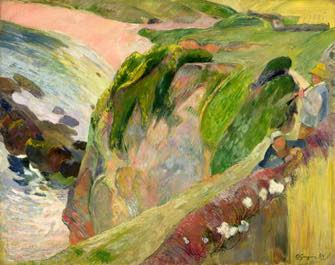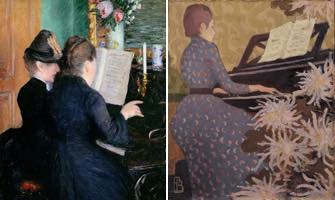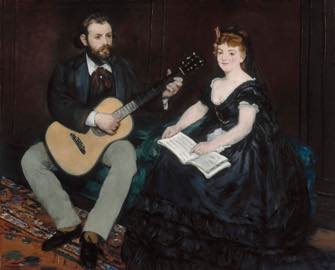
Every year, the Musée des Impressionnismes puts on two interesting exhibitions that give people another reason to visit Giverny during the spring and summer – the other one being, of course, Monet’s garden. This year’s first show is “Tintamarre! Instruments de Musique dans l’Art, 1860-1910.” (“In Concert! Musical Instruments in Art, 1860-1910”).
Unfortunately, the wonderful onomatopoeic word “tintamarre” does not translate well into English, in which it has the pejorative connotation of “din” or “racket.” In French, it can mean “din,” too, but it also has a friendlier, more festive sound. It was a popular word in France during the period covered by the show.
In any case, the music referred to in the artworks here was surely more harmonious than the word “tintamarre” implies. The exhibition is not about the attempts of artists like Kandinsky to translate music into painting, but the representation of musical instruments in art at the end of the 19th century and the beginning of the 20th.
In the second half of the 19th century, musical performances multiplied on the streets and in concert, opera and dance halls. At the same time, as modern musical instruments became more readily available and the middle classes grew wealthier, more people had instruments at home and were learning to play them and giving private concerts at home.
The first part of the show looks at public performances, ranging from itinerant musicians playing in courtyards in hopes that residents would throw coins to them from the windows to concerts of all sorts. An amusing 1903 canvas by Georges Lemmen gives a plunging view from the balcony of a performance of Wagner’s Götterdämmerung at the Théâtre de la Monnaie in Brussels, complete with a zoftig Brünnhilde and a gesticulating Siegfried, while Jean Béraud takes us into a popular music hall in “Revue au Théâtre des Variétés” (c. 1883), in which he manages to give equal billing to two players on the stage, audience members in a box and the orchestra in the pit.
Music lessons in the privacy of the home offered plenty of fodder for artists of the day (although they certainly weren’t the first; think of Vermeer’s “The Music Lesson,” to name just one example). Here we have Gustave Caillebotte’s touching “Piano Lesson”(1881), in which we see two bourgeois ladies, one of

whom still has her hat on, assiduously applying themselves to the work at hand. Pierre Bonnard shows a woman alone playing in a similar position (how to depict someone at an upright piano was a problem for painters, since they usually have their back turned) in his Japanese-print-influenced “Jeune Femme au Piano.” The intense concentration required to learn an instrument is palpably depicted in Henri de Toulouse-Lautrec’s “Mademoiselle Dihau au Piano” (1890).
The time-honored music-inspired seduction scene is shown in René Prinet’s “Kreutzer’s Sonata” (1901), in which a violinist, holding his instrument up in the air out of harm’s way, passionately grasps the begowned pianist around the waist while lifting her up to kiss her. In Tolstoy’s novel of the same name, the ability to arouse great passion is attributed to this sonata. This painting had a second life in the 1940s in advertising for the perfume Tabu.
John Singer Sargent, a musician himself, used the piano in his studio as a mere prop in his 1897 portrait of Catherine Vlasto, who leans elegantly against the instrument in her beautiful white dress with satin bows, her hand on the keyboard.
James Tissot, a painter of high-society scenes straight out of Proust, gets a laugh with his painting “Trop Tôt” (1873), in which guests in their best finery have arrived too early for a musical evening. They stand around uncomfortably in the drawing room chatting among themselves while the hostess gives last-minute instructions to the musicians and two servants peep curiously through a doorway.
Another amusing piece is a painting by Pierre-Franc Lamy that was intended to be reproduced on a fan. It shows the famed salon of poet Nina de Callias, who received her visitors at midnight, but always in the presence of her mother – seen sternly watching as her daughter plays the piano while a gentleman caller hovers over her – to keep up appearances. (De Callias was also, incidentally, the model for Édouard Manet’s “La Dame aux Éventails,” or “The Lady with Fans.”)
Many of the great painters of the period – in addition to those already mentioned, they include Manet, Auguste Renoir, Gustave

Doré, Edgar Degas, Walter Sickert and James Ensor – are represented in the show and, while some of the works are minor, the charm of the subject is more than enough to hold visitors’ interest and inspire them to leave humming a tune or even ready to finally learn to play the piano.
Favorite